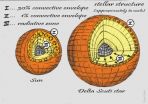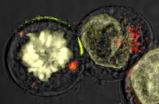(Press-News.org) This press release is available in German.
The stars are boiling! The reason is the energy generated in the center of the star that wants to escape. If this does not happen quickly enough, the star starts to 'boil' in the outer layers causing vibrations that result in light variations, like in the Sun. Such oscillations have now been discovered by Victoria Antoci and collaborators using the NASA spacecraft Kepler, but in a much hotter star. The scientists publish this in the most recent issue of Nature.
Besides the discovery of earth-like planets, astronomy is concerned with research on stellar oscillations, among many other topics. The vibrations cause periodic brightness variations of some stars. Asteroseismology works just like the seismic exploration of the Earth's interior: the frequencies of seismic waves depend on mass and composition of a body and therefore allow to tomographically reproduce its interior structure.
What causes stellar oscillations?
Several mechanisms maintain periodic oscillations in stars. In the Sun it is "seething" (convection) in the outer layers, comparable with boiling water and the consequent audible sound of the pot. In stars with masses some 1.5 times solar and more it is the so-called "kappa mechanism" that excites periodic pulsations. "This process works like a heat or Diesel engine" explains Victoria Antoci from the Institute of Astronomy at the University of Vienna.
Stellar structure
Because of decades of research on solar oscillations it is known that the energy in the outer 30 per cent of the solar radius is transported by convection and below that, energy is transported by radiation.
In stars twice as massive, only one per cent of the envelope is convective. Also in this case, the energy generated in the core is transported by radiation. Stars with even higher mass should no longer possess a convective envelope. However, where exactly it disappears is unknown because of the extreme physical conditions in this domain.
One possibility to explore this is asteroseismology of so-called Delta Scuti stars. These stars are in the mass range where the convective envelope disappears. Delta Scuti stars show periodic light variations due to pulsations excited by the kappa mechanism. "Since more than ten years, scientists predicted that despite the small depth (one per cent) of the convective envelope of Delta Scuti stars convection should have sufficient energy to excite solar-like pulsations as well. Finally we succeeded to prove this", Victoria Antoci is pleased.
"Kepler" confirms the theory
In the framework of her PhD thesis the scientist examined hundreds of stars observed with NASA's Kepler space telescope for solar-like oscillations and made a detection: the Delta Scuti star called HD 187547 is the first representative of the group showing both types of oscillations. "With HD 187547 we found the ideal object to study different processes and their interaction under extreme physical conditions" says Gerald Handler from Nicolaus Copernicus Center in Warsaw, the advisor of Victoria Antoci's dissertation.
Statements about the actual depth of the outer convective layer are possible for the first time thanks to the work published in "Nature", as is a calibration of convection models in this temperature domain. In addition, the presence of two different types of stellar oscillations permits to model the interior structure of HD 187547 with unprecedented precision. The scientists also determined that HD 187547 has unusual abundances of certain chemical elements on its surface, most probably a consequence of slow stellar rotation. Heavy elements dwindle down and become less abundant in the star's spectrum (only the stellar surface is directly observable). On the other hand, light elements are pushed upwards and appear more abundant. This physical process is known as diffusion and is not fully understood in stars such as HD 187547.
INFORMATION:
Publication
The excitation of solar-like oscillations in a Sct star by efficient envelope convection
V. Antoci, G. Handler, T. L. Campante, A. O. Thygesen, A. Moya, T., Kallinger, D. Stello, A. Grigahcene, H. Kjeldsen, T. R. Bedding, T. Lüftinger, J. Christensen-Dalsgaard, G. Catanzaro, A. Frasca, P. De Cat, K. Uytterhoeven, H. Bruntt, G. Houdek, D. W. Kurtz, P. Lenz, A. Kaiser, J. Van Cleve, C. Allen & B. D. Clarke. In: Nature, September 14, 2011.
DOI:10.1038/nature10389.
Abstract: http://www.nature.com/nature/journal/vaop/ncurrent/abs/nature10389.html
The turbulent lives of stars
2011-09-16
ELSE PRESS RELEASES FROM THIS DATE:
Serotonin levels affect the brain's response to anger
2011-09-16
Fluctuations of serotonin levels in the brain, which often occur when someone hasn't eaten or is stressed, affects brain regions that enable people to regulate anger, new research from the University of Cambridge has shown.
Although reduced serotonin levels have previously been implicated in aggression, this is the first study which has shown how this chemical helps regulate behaviour in the brain as well as why some individuals may be more prone to aggression. The research findings were published today, 15 September, in the journal Biological Psychiatry.
For the study, ...
Two-thirds of hepatitis C patients can see a cure in half the time, new study finds
2011-09-16
LOS ANGELES (Sept. 15, 2011) – Treatment with a telaprevir-based combination regimen for hepatitis C – heretofore a chronic, destructive and difficult to manage disease – effectively can be shortened to six months in about two-thirds of patients, finds a new study published Thursday in the New England Journal of Medicine.
Telaprevir, a drug approved for use against hepatitis C in May, inhibits replication of virus. This anti-viral drug and a similar medication called boceprevir have nearly doubled the number of patients with sustained response. Among patients treated ...
Sabal Financial Group, L.P. Announces the Acquisition of $158 Million Loan Portfolio through FDIC's Small Investor Program
2011-09-16
Sabal Financial Group, L.P., formerly Milestone Asset Resolution Company, LLC, a diversified financial services management firm, announces the recent acquisition of a $158 million portfolio of performing and non-performing commercial real estate loans and commercial acquisition, development and construction loans and credit facilities. The acquisition represents the first sale transaction under the FDIC's pilot Small Investor Program ("SIP") and represents the commercial loan component of a larger $297 million loan sale mandated by the FDIC for the assets of failed ...
Small group homes are better for many dementia patients and their families
2011-09-16
Small group homes for people with dementia provide good quality care and a domestic environment where people can live as individuals and families can get involved. But tension can arise when it comes to deciding who takes responsibilities for certain practical and caring tasks.
Those are the key findings of a study of two group living care homes in the Netherlands, published in the September issue of the Journal of Clinical Nursing.
"It's estimated that 80 million people worldwide will suffer from dementia by 2040" says Ezra van Zadelhoff from Maastricht University. ...
All credit ratings not created equal
2011-09-16
At least one of the "Big Three" credit ratings agencies exaggerated credit scores of private debt compared to public bonds during the last 30 years, according to a new study by researchers from Rice University, American University and Indiana University.
The recent downgrade of U.S. debt by Standard & Poor's makes the study timely, and the research adds to the current debate surrounding regulatory reliance on credit ratings and the current Securities and Exchange Commission proposal to standardize credit ratings across asset classes.
For the study, "Credit Ratings ...
Plants create a water reserve in the soil
2011-09-16
It has long been known that roots alter the soil in their immediate vicinity, where other microorganisms live and the chemical composition is altered compared to that further away from the roots. An international research team has now demonstrated in experiments at the Paul Scherrer Institute that the soil in the vicinity of roots also contains more water – contrary to the earlier belief that there must be less water in this region, as the plant takes up water from the soil. Apparently, however, plants create a small water reserve that helps to tide them over through short ...
Stents may reduce heart attacks by delivering downstream medication
2011-09-16
Tuesday, September 13, 2011, Cleveland: Researchers at Cleveland Clinic have discovered that cardiac patients receiving medicated stents – a procedure that occurs often when blood vessels are blocked – have a lower likelihood of suffering heart attacks or developing new blockages in the vessel downstream from the stent.
Stents have been used to prevent re-narrowing of coronary arteries after balloon angioplasty and newer designs have included coatings with medications to prevent re-narrowing from occurring within the stent after implantation. The recent study – led by ...
Highlights of the 24th Congress of the European College of Neuropsychopharmacology (ECNP) 2011
2011-09-16
September 2011, Paris, France
The 24th ECNP Congress, which was held from 3 to 7 September 2011 in Paris, France, was once again a great success, bringing together more than 6,700 psychiatrists, neurologists, psychologists and neuroscience researchers from all over the world. ECNP is especially pleased to see an increasing number of delegates coming from outside Europe.
The annual ECNP Congress is the largest scientific meeting on mental and neurological health in Europe, promoting fruitful dialogue between neuroscientists and medical professionals. With more than ...
Cancer-killing cells are caught on film in more 3-D detail than ever before
2011-09-16
Scientists reveal in more detail than ever before how white blood cells kill diseased tissue using deadly granules, in research published today in PLoS Biology.
The researchers, from Imperial College London and the University of Oxford, used 'optical' laser tweezers and a super-resolution microscope to see the inner workings of white blood cells at the highest resolution ever. The researchers describe how a white blood cell rearranges its scaffolding of actin proteins on the inside of its membrane, to create a hole through which it delivers deadly enzyme-filled granules ...
Childhood and the driving force of fashion
2011-09-16
Are children as young as five years old so driven by consumerism and fashion that they are in danger of 'losing' their childhood?
Not necessarily, according to Dr Jane Pilcher, a sociologist at the University of Leicester, whose research findings on children and fashion were recently reported in the international journal, Childhood.
Nonetheless, her findings showed that brands and logos are highly important to some children, influenced by family attitudes, peer pressure and celebrity culture.
The desire for certain brands and logos, especially in boys' sportswear, ...


